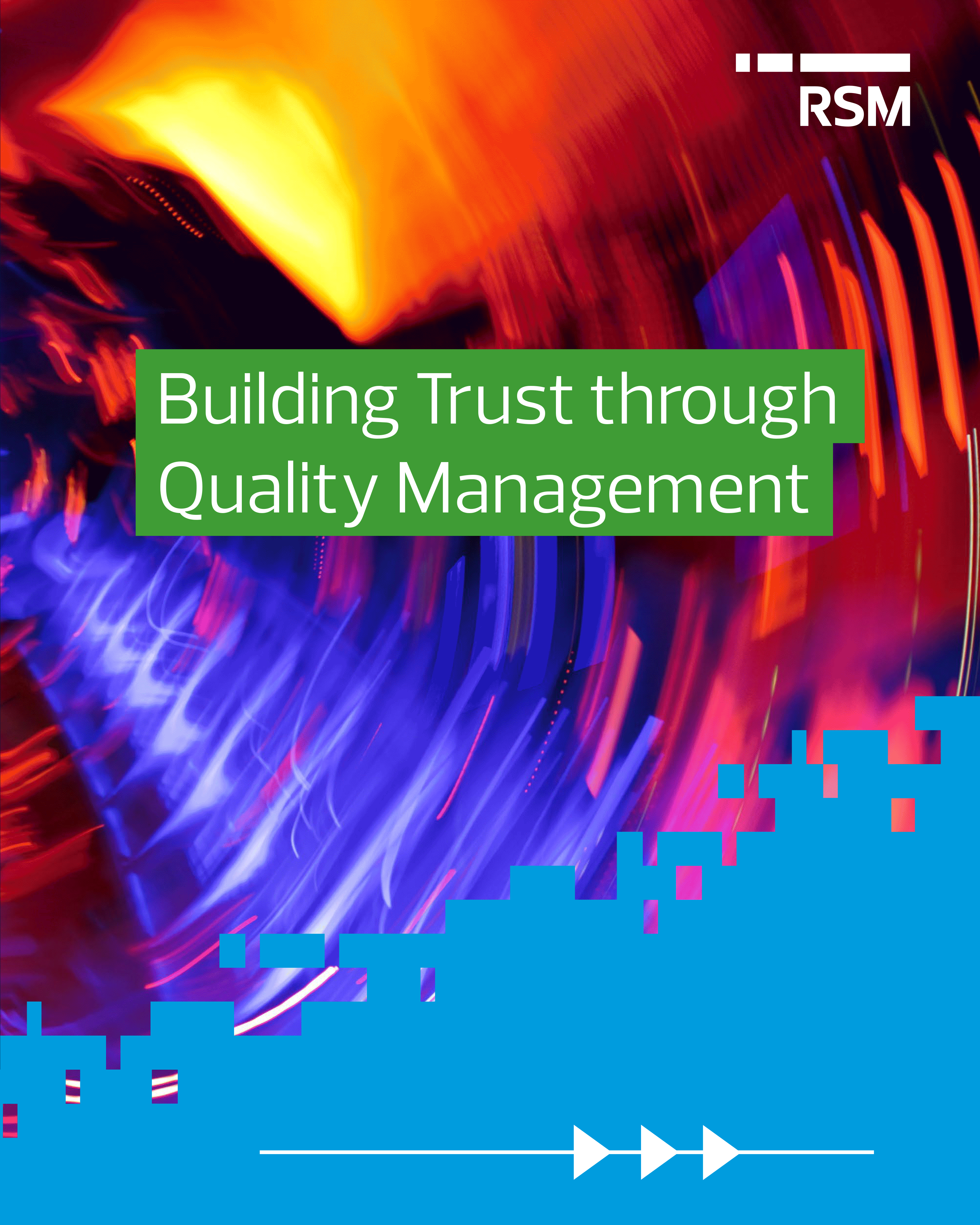The impact of the transition from the previous International Standard on Quality Control (ISQC 1) into the International Standard on Quality Management (ISQM 1) adopted two years ago is now clear. The shift from a focus on compliance to a focus on management of audit quality has had a notable impact on audit firms over recent years.
Audit firms are now prioritising managing risks rather than focusing on controlling them.
So, what's the difference
between "managing"
and "controlling"?

Under ISQM, quality management is an ongoing and dynamic process. Firms must establish a system that is proactive rather than reactive in managing quality. Managing is a much broader task which not only incorporates the identification of the firm's quality objectives, recognition of those risks that could hinder the achievement of these objectives, and the development of those policies, procedures, and strategies to mitigate them but also emphasises the ongoing evaluation and dynamic response to changes.
Under ISQM, the quality management system is constantly evolving. Below we aim to define best practices to follow and identify frequent pitfalls to avoid. By improving the monitoring and remedial procedures of an audit firm's quality management system, practitioners can become more efficient and focused on achieving results.
Step 1: Avoid Routine Tests
For an effective quality management, monitoring needs to be comprehensive, thorough and integrated within the firm's practices and procedures.
Relying on periodic or surface-level checks that don't capture underlying issues is a common mistake that needs to be avoided in the process.
The greater the integration into the practice, the earlier issues can be detected, allowing for timely and proactive action. Training staff to recognise these indicators and using automated tools for real-time data collection can make monitoring more comprehensive and effective.
Example: Establish a monitoring mechanism for timely submission of timesheets that will allow to manage work overload and identify resource shortages.
Step 2: Investigate deeper to Determine the True Causes
Informal analyses that overlook more complex issues can lead to incomplete and partial solutions that fail to address the real causes.
Adopting methods like the "5 Whys" encourages a more detailed investigation, looking beyond surface symptoms to identify the contributing factors. By addressing the actual root causes, firms can implement solutions that prevent recurring issues and strengthen quality management overall.
Example: The surface issue seemed to be simple mistakes in applying a new regulatory standard, but further analysis revealed that the auditors lacked in-depth training on the standard itself.
Step 3: Start with the riskiest first
Don't prioritise all concerns and issues as if they are of the same urgency and importance. This can put too much pressure on the resources on hand and lead to insufficient attention to the most pressing problems.
Audit firms can allocate resources more effectively by classifying issues according to their risk profile. This prioritisation creates a practical roadmap, enabling systematic action without overburdening resources.
Example: Utilisation of a risk matrix can help categorise the findings and focus resources on high-priority areas such as client projects with complex compliance requirements, making sure important issues are addressed right away.
The path to Quality

After two years of monitoring quality management systems under the revised ISQM standards, I can confidently say that managing risks effectively is the key to lasting excellence and quality. It’s a never-ending journey, as new ideas, innovations, and risks emerge each year. Satisfied clients combined with engaged staff are the true reward to the hard work invested in maintaining high standards.
Step 4: Create customised and practical fixes for real results
A common pitfall here is relying on quick fixes that result in short-term solutions that can worsen the issues in the long run.
Avoid using one-size-fits-all solutions. Remedial solutions should be tailored to the needs of all significant stakeholders in order to guarantee long-lasting results. Documentation, process enhancements, and focused training are a few possible solutions. Businesses can achieve significant and long-lasting progress by concentrating on the true underlying issues.
Example: Based on the ongoing monitoring activities, create a custom-made action plan that is unique to each circumstance. Insert realistic timelines to manage its implementation.
Step 5: Monitor, measure, modify, repeat
Failing to follow up can create a cycle of recurring problems, slowly weakening quality standards.
Setting key performance indicators (KPIs) allows you to measure the impact of changes, while feedback loops enable you to make any additional necessary adjustments. Frequent evaluations help stop the recurrence of old issues from coming back and keep quality standards strong over time.
Example: After remediation, successful firms measure progress with key performance indicators (KPIs) and check in after three to six months to see if the changes are working. Some issues may need to be revisited multiple times until the desired result is obtained.
Step 6: Establish a culture of quality
Top management cannot drive quality on its own, which may reduce employee engagement throughout the organisation.
Open communication channels need to be established, and the staff needs to be encouraged to use them to share their insights. Individuals and teams' efforts need to be acknowledged and celebrated to highlight the significance of good practices, transforming them into shared responsibility across the firm.
Example: The "tone at the top" can be established by the leadership living the firm's values while being directly involved in the delivery and training. All members are inspired to contribute to high standards while actively participating in quality initiatives.
Quality management is not an administrative task or burden. It is what can create trust within our profession. Identifying the root causes, planning enhancements and continuously monitoring the outcomes prove the dedication to upholding confidence in the quality of the audit outputs.
Contact us
To learn more about our audit and assurance services, get in contact with us today
or make an appointment at one of our Cyprus office locations.


